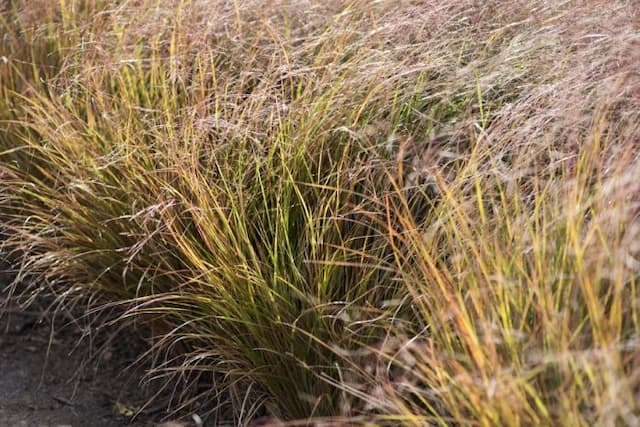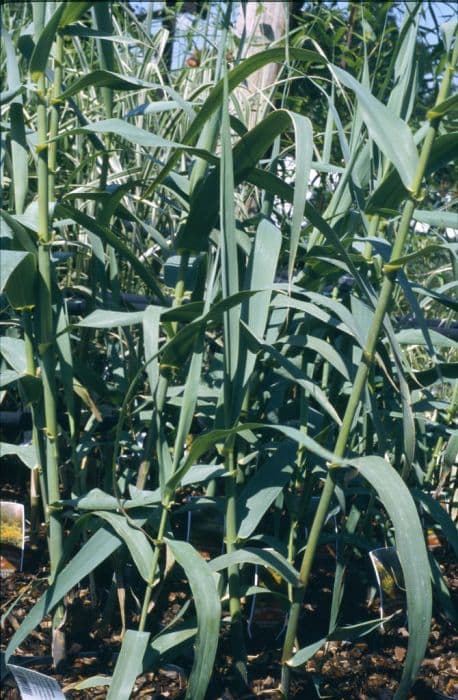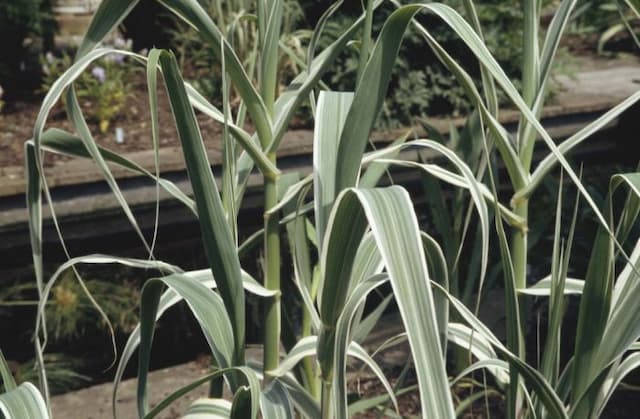Tufted Hairgrass Deschampsia cespitosa

ABOUT
The plant commonly known as tufted hair grass is a perennial grass that forms dense, dark green clumps. The foliage is fine and hair-like, which is how it earned its common name. During the growing season, the leaves often arch elegantly, creating a fountain-like effect with their narrow blades. The most striking feature of this grass is its airy, delicate flower panicles that emerge above the foliage in summer. These panicles typically carry a multitude of tiny flowers, which can vary in color from silvery-green to golden-brown as they mature and often catch the light, giving the plant a shimmering appearance. The flowers' delicate nature gives them a wispy, feathery look that is highly valued in ornamental landscaping for its texture and movement. As the seasons change, the plant takes on a golden hue in the fall, providing visual interest throughout multiple seasons.
About this plant
 Names
NamesFamily
Poaceae.
Synonyms
Tufted Hairgrass, Tussock Grass, Hassock Grass, Bronze Veil.
Common names
Avenella cespitosa, Aira cespitosa, Deschampsia bottnica, Deschampsia caespitosa, Deschampsia cespitosa var. bottnica, Deschampsia cespitosa var. coarctata, Deschampsia cespitosa var. glauca, Deschampsia coarctata, Deschampsia glauca, Deschampsia glaucescens, Deschampsia inaequalis.
 Toxicity
ToxicityTo humans
Tufted hairgrass (Deschampsia cespitosa) is not commonly known to be toxic to humans. There are no significant reports of poisoning or adverse reactions from ingesting or handling this plant.
To pets
Tufted hairgrass is also not known to be toxic to pets. It should not cause any harm if pets come into contact with or ingest this grass. However, as with any plant, individual allergic reactions or digestive upset could occur from ingesting plants that are not part of a regular diet. Always monitor pets for any signs of distress after ingesting unfamiliar plants.
 Characteristics
CharacteristicsLife cycle
Perennials
Foliage type
Evergreen
Color of leaves
Green
Flower color
Green
Height
2-3 feet [0.6-0.9 meters]
Spread
2-3 feet [0.6-0.9 meters]
Plant type
Grass
Hardiness zones
4-9
Native area
Northern Hemisphere
Benefits
 General Benefits
General Benefits- Ornamental value: Deschampsia cespitosa, commonly known as Tufted Hairgrass, is appreciated for its fine-textured foliage and airy, cloud-like flower panicles that add aesthetic beauty to gardens and landscapes.
- Wildlife habitat: It provides shelter and nesting material for birds and small mammals, while its seeds serve as a food source.
- Erosion control: The dense, fibrous root system of Tufted Hairgrass helps stabilize soil and prevent erosion, particularly on slopes and banks.
- Drought tolerance: Once established, it is relatively drought-tolerant, requiring minimal irrigation and making it suitable for xeric landscaping.
- Low maintenance: It requires very little maintenance in terms of fertilization or pruning, ideal for those seeking a low-care garden addition.
- Cold hardiness: This grass is tolerant of cold temperatures, making it useful in a variety of climates, including those with harsh winters.
- Tolerance of poor soils: Tufted Hairgrass can grow in a range of soil conditions, including poor and acidic soils, where other plants might struggle.
- Adaptability: It can thrive in both full sun and partial shade, providing flexibility in garden design and plant placement.
 Medical Properties
Medical PropertiesThis plant is not used for medical purposes.
 Air-purifying Qualities
Air-purifying QualitiesThis plant is not specifically known for air purifying qualities.
 Other Uses
Other Uses- Deschampsia cespitosa, commonly known as tufted hairgrass, is often used in landscaping and garden design due to its ornamental grassy clumps which provide textural contrast.
- The inflorescences of tufted hairgrass can be dried and used in floral arrangements, adding a delicate and wispy element to bouquets.
- In ecological restoration projects, tufted hairgrass is planted for erosion control as its dense root system helps to stabilize soil on slopes and banks.
- Tufted hairgrass serves as a host plant for butterfly and moth larvae, contributing to biodiversity and supporting insect populations.
- This grass has been utilized in horticulture as a cool-season accent in meadow gardens, where it sways attractively in the breeze.
- Farmers sometimes include tufted hairgrass in pasture grass mixes for low-fertility soils where other forage grasses may not thrive as well.
- It is occasionally used as fodder for livestock, particularly in areas where few other palatable grasses are available.
- Tufted hairgrass is suitable for planting in rain gardens, which are designed to absorb rainwater runoff and reduce the impact on stormwater systems.
- In craft work, artisans utilize the long strands of dried tufted hairgrass inflorescences to create natural weavings and basketry.
- Due to its tolerance to heavy metals, tufted hairgrass is sometimes used in phytoremediation to help clean contaminated soils.
Interesting Facts
 Feng Shui
Feng ShuiThe Tufted Hairgrass is not used in Feng Shui practice.
 Zodiac Sign Compitability
Zodiac Sign CompitabilityThe Tufted Hairgrass is not used in astrology practice.
 Plant Symbolism
Plant Symbolism- Resilience: Deschampsia cespitosa, commonly known as Tufted Hairgrass, is known for its ability to thrive in a wide range of environments, symbolizing the ability to adapt and survive through difficult conditions.
- Nature’s Artistry: With its delicate, feathery seed heads that sway in the breeze, Tufted Hairgrass showcases nature’s delicate craftsmanship, representing natural beauty and aesthetic grace.
- Graceful Aging: As Tufted Hairgrass transitions from green to golden hues in the fall, it symbolizes the beauty and dignity that can come with age and the passage of time.
- Flexibility: The grass’s flowing movement in the wind exemplifies the quality of flexibility, suggesting the importance of bending without breaking in order to withstand life’s challenges.
 Water
WaterThe common name for Deschampsia cespitosa is Tufted Hair Grass. It prefers consistent moisture and should be watered deeply once a week to ensure the soil remains moist but not waterlogged. This grass can be watered by soaking the base of the plant until the water penetrates the soil to a depth of at least 6 inches. Depending on weather conditions, like high heat or dry winds, you may need to water twice a week. In a typical watering session, Tufted Hair Grass will benefit from approximately 1 to 1.5 gallons of water, ensuring the root zone is adequately saturated.
 Light
LightTufted Hair Grass thrives in full sun to partial shade conditions. The best spot for this plant would be an area where it receives at least 4 to 6 hours of sunlight daily. However, in hotter climates, providing some afternoon shade will help protect the grass from excessive heat.
 Temperature
TemperatureTufted Hair Grass prefers a wide range of temperatures but grows best in cooler conditions between 60°F and 75°F. It can tolerate temperatures down to about 5°F but may go dormant until warmer weather returns. At the high end, this grass can survive brief periods of temperatures up to 90°F, especially with adequate water and some shade.
 Pruning
PruningTufted Hair Grass should be pruned to remove old foliage and make way for new growth, typically done in the early spring before the new growing season starts. Pruning involves cutting back the grass to about 2 to 4 inches above the ground. It is usually sufficient to prune once a year, as this maintains the plant's natural shape and encourages healthy, dense growth.
 Cleaning
CleaningAs needed
 Soil
SoilTufted Hair Grass thrives in a soil mix with good drainage; a combination of loam, peat, or compost with a bit of sand works well. The pH should be slightly acidic to neutral, roughly between 5.5 and 7.2.
 Repotting
RepottingTufted Hair Grass is typically a garden plant and does not require potting; if grown in containers, repotting every 2 to 3 years is suitable to refresh the soil and divide if necessary.
 Humidity & Misting
Humidity & MistingTufted Hair Grass tolerates a wide range of humidity conditions and does not have specific humidity requirements, making it suitable for various outdoor climates.
 Suitable locations
Suitable locationsIndoor
Place the Tufted Hair Grass in bright indirect light.
Outdoor
Plant in full sun to part shade and water regularly.
Hardiness zone
4-9 USDA
 Life cycle
Life cycleTufted Hairgrass (Deschampsia cespitosa) begins its life cycle when seeds germinate, typically in early spring, needing light and moist, well-drained soil. The seedlings develop into a clump of grass, using its fibrous root system to establish a strong foundation. As the plant matures, it develops narrow, fine-textured leaves that form dense, tussock-like clumps. Following this vegetative stage, the plant enters its reproductive phase in late spring to summer, where it produces tall, airy flowering stalks topped with feathery panicles. Pollination occurs via wind, leading to seed set. The life cycle is completed when the plant dies back in winter, dropping seeds to the ground to start the next generation of growth in the coming spring.
 Propogation
PropogationPropogation time
Spring-early summer
Propogation: Tufted Hair Grass is usually propagated by seed in the spring. The most popular method of propagation for this plant is through seed sowing. Collect the seeds from the mature plants during late summer and directly sow them into a prepared seed bed or start them indoors. If starting indoors, use a light seed-starting mix and press the seeds gently into the surface of the soil, because they need light to germinate. Keep the soil moist but not saturated and maintain a temperature of around 65-70°F (approximately 18-21°C), as the seeds require warmth to germinate. Seedlings can then be transplanted outside after the risk of frost has passed, spacing them about 12 to 18 inches (30 to 45 centimeters) apart to allow for mature growth.









